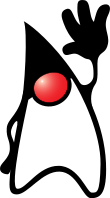Java Programmer
COURTESY :- vrindawan.in
Wikipedia
Java is the name of a programming language created by Sun Micro systems. This company was bought out by Oracle Corporation, which continues to keep it up to date. As of September 2022, Java 19 is the latest version, released in September 2022 (will be supported until March 2023) while Java 17, 11 and 8 are the current long-term support (LTS) versions, with Java 17 released on September 14th, 2021. Being an LTS version means that it will continue getting updates for multiple years. The next planned LTS version is Java 21 (LTS), planned for September 2023.

Being an open-source platform, Java isn’t just supported by Oracle, e.g. Eclipse Adoptium also supports Java, to at least May 2026 for Java 8, and at least September 2027 for Java 17.
Java, which was called Oak when it was still being developed, is object oriented, meaning it is based on objects that work together to make programs do their jobs. Java code looks like C, C++, or C#, but code written in those languages will not work in Java in most cases without being changed.
Java runs on many different operating systems, including Android, the world’s most popular mobile operating system (while Java continues to be used on Android, even by its maker Google, they no longer prefer Java; now Kotlin is their preferred language, though it can also be used with all Java code). This makes Java platform independent. It does this by making the Java compiler turn code into Java byte code instead of machine code. This means that when the program is executed, the Java Virtual Machine interprets the byte code and translates it into machine code.
Java was developed to achieve five main goals. These are:
- Java should be easy to learn, object-oriented, and distributed.
- Java should be safe and strong.
- Java should not depend on any computer architecture or platform.
- Java should function well.
- Java should be able to have an interpreter written for it (for better portability), support parallelism, and use dynamic typing.
The Java platform refers to a group of software products from Sun Micro systems. The platform is used to develop and run Java programs. The platform includes the execution engine (called a Java Virtual Machine) that allows Java programs to do the same thing on different computer systems.
This capability of being able to develop software on one platform and running it on other platforms is called “cross-platform capability”.
ava was originally developed by James Gosling at Sun Microsystems. It was released in May 1995 as a core component of Sun Microsystems’ Java platform. The original and reference implementation Java compilers, virtual machines, and class libraries were originally released by Sun under proprietary licenses. As of May 2007, in compliance with the specifications of the Java Community Process, Sun had relicensed most of its Java technologies under the GPL-2.0-only license. Oracle offers its own HotSpot Java Virtual Machine, however the official reference implementation is the OpenJDK JVM which is free open-source software and used by most developers and is the default JVM for almost all Linux distributions.
As of September 2022, Java 19 is the latest version, while Java 17, 11 and 8 are the current long-term support (LTS) versions.
James Gosling, Mike Sheridan, and Patrick Naughton initiated the Java language project in June 1991. Java was originally designed for interactive television, but it was too advanced for the digital cable television industry at the time. The language was initially called Oak after an oak tree that stood outside Gosling’s office. Later the project went by the name Green and was finally renamed Java, from Java coffee, a type of coffee from Indonesia. Gosling designed Java with a C/C++-style syntax that system and application programmers would find familiar.
Sun Microsystems released the first public implementation as Java 1.0 in 1996. It promised write once, run anywhere (WORA) functionality, providing no-cost run-times on popular platforms. Fairly secure and featuring configurable security, it allowed network- and file-access restrictions. Major web browsers soon incorporated the ability to run Java applets within web pages, and Java quickly became popular. The Java 1.0 compiler was re-written in Java by Arthur van Hoff to comply strictly with the Java 1.0 language specification. With the advent of Java 2 (released initially as J2SE 1.2 in December 1998 – 1999), new versions had multiple configurations built for different types of platforms. J2EE included technologies and APIs for enterprise applications typically run in server environments, while J2ME featured APIs optimized for mobile applications. The desktop version was renamed J2SE. In 2006, for marketing purposes, Sun renamed new J2 versions as Java EE, Java ME, and Java SE, respectively.
In 1997, Sun Microsystems approached the ISO/IEC JTC 1 standards body and later the Ecma International to formalize Java, but it soon withdrew from the process. Java remains a de facto standard, controlled through the Java Community Process. At one time, Sun made most of its Java implementations available without charge, despite their proprietary software status. Sun generated revenue from Java through the selling of licenses for specialized products such as the Java Enterprise System.
